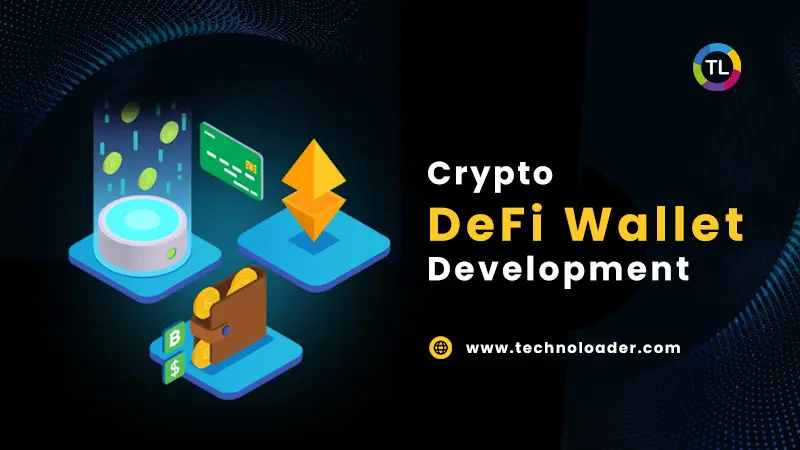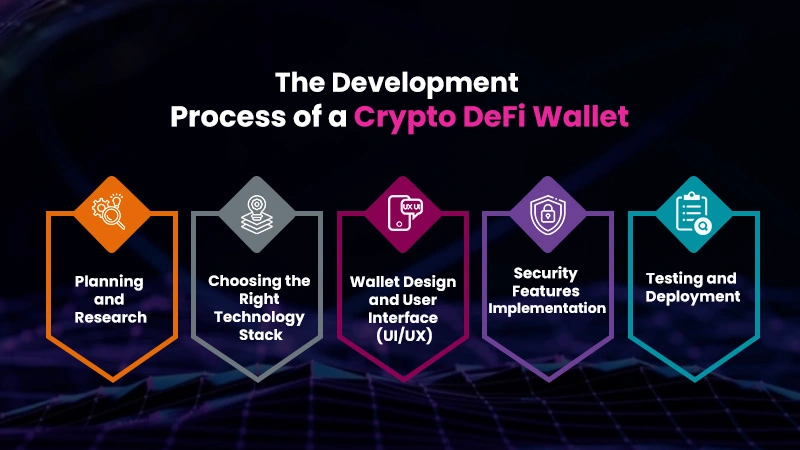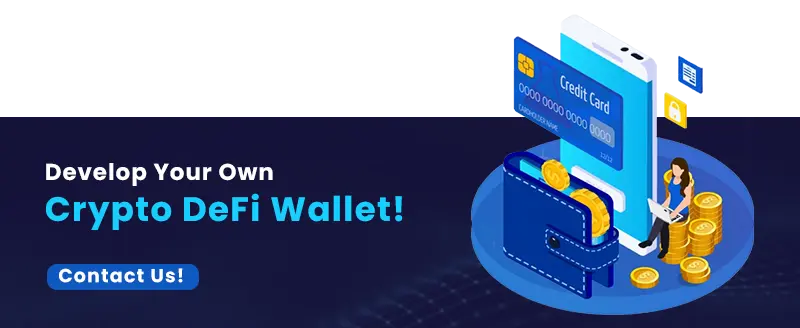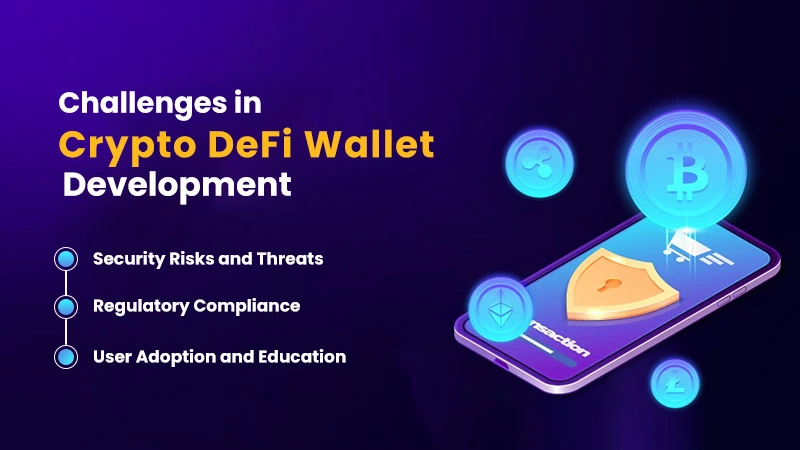With the increasing popularity of cryptocurrency, one name that stands atop the crypto world is DeFi wallets.
DeFi wallets aka smart contract wallets are non-custodial cryptocurrency wallets that provide their users with complete authority over how they store and trade their funds. If you are also looking for complete guidance on crypto DeFi wallet development, this blog is for you.
In this blog, we’ll be discussing everything you need to know about crypto DeFi wallet development, from its key features to the future of DeFi wallets!
So, without further ado, let’s get started –
Table of Contents
Key Features of DeFi Wallets
Here are the key features of DeFi wallets that make them different from the rest –
Decentralization and User Control Over Funds
As the name suggests, the most important feature of a DeFi wallet is decentralization. Contrary to traditional centralized wallets, where banks or third-party intermediaries manage your funds, DeFi wallets give users complete control over funds.
In DeFi wallets, users hold the private key, meaning only those can access the funds. This, consequently, eliminates the need for a centralized authority, giving users complete authorization over the funds.
The ability to operate and store funds independently is a cornerstone of DeFi wallets, providing great financial flexibility.
Integration with DeFi Protocols and Platforms
DeFi wallets are designed in a way that makes it quite seamless for them to integrate with other decentralized financial systems. Simply put, it allows the users to borrow, lend, trade, pay dividends, and earn interest directly from the wallet.
Proper integration of DEXs, lending protocols and yield farming platforms allows users to access a wide range of features without having to switch platforms.
This ease of use makes the DeFi wallet a one-stop solution for connecting to the DeFi ecosystem.
Multi-chain Support and Asset Management
Another important feature of DeFi wallets is their multi-chain support. This wallet allows users to manage assets on multiple blockchains, such as Ethereum, Binance Smart Chain, Solana, and more. Multichain integration provides flexibility and convenience as users can access and manage cryptocurrencies and tokens in one place. This feature also opens up opportunities for cross-chain swaps and transactions, increasing the overall profitability of the wallet.
Enhanced Security Features
Security is paramount for DeFi wallet users, and many wallets offer advanced security features to protect users’ assets. Features like multi-signature support (which requires multiple approvals for transactions) and hardware wallet compatibility for added security. These measures ensure that the assets remain secure even in the event of a key failure. Additionally, hardware wallet integration helps in accessing offline private keys, reducing the risk of an online hack.
The Development Process of a Crypto DeFi Wallet
Let’s get started with the crypto DeFi wallet development process. We’ll be covering everything from initial planning to final deployment –
Step 1: Planning and Research:
Comprehensive planning and research are the first steps in creating a crypto DeFi wallet. This stage begins by identifying the target audience, such as crypto enthusiasts, investors, or everyday users, and understanding their specific needs.
Next, it’s time to analyze the existing competition and identify its key features, benefits, and functionality. Understanding all these factors will help you come up with the unique selling points of your crypto DeFi wallet.
Understand what the market already has, what it needs, and what it demands in order to ensure your DeFi wallet doesn’t miss out on any crucial feature.
Step 2: Choosing the Right Technology Stack:
The next and major step in crypto DeFi wallet development is choosing the right technology stack. It starts with choosing the right blockchain platform based on transaction speed, scalability, and user demand. Some popular options are Ethereum, Binance Smart Chain, or Solana. The blockchain you choose for your DeFi wallet will be responsible for the wallet performance and multi-chain compatibility.
Now, smart contract development and integration come into play. Smart contracts are important for automating decentralized transactions, such as swaps, lending, and in-wallet staking. In order to enhance the wallet’s overall performance, security, and functionality, it is highly important to ensure that the smart contract is secure, efficient, and properly integrated into the wallet.
Step 3: Wallet Design and User Interface (UI/UX):
If you want to make your DeFi wallet appealing to users, it is important to create a user-friendly design for your crypto DeFi wallet. The simple and intuitive UI/UX ensures that even users with no prior experience of using a crypto wallet can easily navigate through the content of the DeFi wallet.
Some important things to consider are that your wallet should clearly show balances, transaction history, and ways to interact with the DeFi protocol, making the experience seamless.
Additionally, make sure your DeFi wallet design is compatible with various devices so that users can access the wallet on both mobile and desktop platforms. The wallet needs to be responsive and optimized for different screen sizes to ensure a consistent and smooth experience on all devices. It significantly increases user satisfaction by providing them with an easy-to-use crypto DeFi wallet.
Step 4: Security Features Implementation:
As we all know, security is one of the most important aspects of the cryptocurrency world. With the rapid increase in online fraud, it has become quite essential for developers to understand the importance of implementing robust security features to their crypto DeFi wallet.
For example, implementing multi-signature functionality is a good option to increase the security of the DeFI wallet by adding multiple layers of approval for each transaction. Additionally, secure private key management is essential – private keys should be stored securely. One great way to do that is to secure them with hardware wallets that keep them offline and inaccessible to hackers.
Step 5: Testing and Deployment:
Following the crypto DeFi wallet development process, the next step involves rigorous testing to ensure that the crypto DeFi wallet is functioning properly.
This includes:
- Unit testing, looking at individual items
- Integration testing, which ensures that modules work well together
- End-to-end testing, which mimics actual user experience to catch any bugs or weaknesses.
Once the wallet passes all the tests, it’s time for the deployment of the DeFi wallet. The deployment phase is critical, as the performance of the wallet must be continuously monitored to address potential real-time issues, security risks, or errors.
Challenges in Crypto DeFi Wallet Development
Developing a crypto DeFi wallet comes with several challenges that developers must address to create a secure, compliant, and user-friendly product. Here are some of the key challenges:
Security Risks and Threats
Security is a major concern in the development of the DeFi wallet. Wallets constantly face threats such as phishing attacks, smart contract vulnerabilities, and private key theft.
In order to minimize the risk, implementing strong practices such as using multiple signatures, hardware wallet integration, and end-to-end encryption is crucial.
Regular code audits and bug finding can help identify potential vulnerabilities before any major attack on the DeFi wallet. Despite these efforts, security remains an ongoing challenge.
Regulatory Compliance
Another major challenge that you’ll face while the crypto DeFi wallet development process is complying with all the complex regulatory requirements. Remember that the law surrounding crypto assets can vary widely based on the jurisdiction. Hence, it can be difficult to comply with anti-money laundering (AML) compliance and know your customer (KYC) laws.
It becomes quite important for developers to keep the DeFi wallet up-to-date with the latest regulations in order to include essential features such as identity verification or transaction tracking that ensure their wallets remain accessible in markets.
User Adoption and Education
One of the biggest major problems that new users face when entering the DeFi wallet space is difficulty in understanding the DeFi wallet interface. Many users find DeFi wallets difficult, and the fear of losing money due to misuse of private keys or misunderstanding of network protocols can lead to a platform switch.
Therefore, developers should focus on creating an intuitive interface and providing clear, accessible tutorials and instructions to educate users on wallet security and usage. Techniques such as in-app tips, FAQs, and customer support can also help streamline the user onboarding process, increasing user retention.
The Future of DeFi Wallets
As the decentralized finance (DeFi) ecosystem continues to evolve, DeFi wallets are also growing rapidly. Moreover, there are new features coming every now and then, shaping the future.
Let’s explore the upcoming trends and the impact of an advanced DeFi wallet on the DeFi ecosystem-
Emerging Trends in DeFi Wallet Development
Here are some of the key future trends in DeFi wallet development –
Interoperability Between Different Blockchains
One of the most important emerging trends in DeFi wallet development is interoperability. As DeFi continues to grow, it is not limited to one blockchain like Ethereum. Instead, DeFi platforms are increasingly spreading across many chains, including Binance Smart Chain, Solana, and Polygon, among others.
Make sure your wallet is interactive enough to allow users to easily manage their assets without having to switch between wallets and platforms. This cross-chain capability will facilitate transactions. Consequently, wallet usage will increase.
Integration with Decentralized Identity (DID) Solutions
Another important feature is the integration of decentralized identification solutions (DID) into the DeFi wallet. DID allows users to control their identity. Therefore, there is no dependence on traditional KYC processes imposed by central authorities. DID solution integration significantly helps in providing users with a more secure and privacy-focused service.
This will help reduce some regulatory barriers by giving users more control over their own information. Additionally, DID integration can improve access to DeFi platforms, allowing users to onboard more easily, especially in environments with strict privacy laws.
The Role of AI and Machine Learning in Enhancing Wallet Security and User Experience
Artificial intelligence (AI) and machine learning (ML) are considered two of the major advancements to improve DeFi wallets.
With the help of AI and ML, it becomes significantly easy to identify suspicious activity, look for patterns with a security threat, and as a result, flag or prevent potentially harmful behavior.
These technologies can also enhance the user experience through personalized recommendations, automated portfolio management, and predictive insights based on user behavior and market data. With AI and ML combined, DeFi wallets can become smarter, more functional, and more user-friendly, This ultimately improves security and usability.
Impact on the DeFi Ecosystem
Let’s discuss what will be the impact of DeFi Wallets on the overall DeFi ecosystem.
Driving Further Adoption of DeFi
As the DeFi wallet becomes increasingly popular, it could play an important role in the decentralized ecosystem. An interactive, AI-enhanced wallet with DID integration will not only provide better performance but also make it easier for new users to interact with the DeFi wallet.
A major part still hesitates to enter the crypto space due to complexity and security concerns. However, by making DeFi more flexible, secure, and user-friendly, the DeFi wallet can appeal to a wider audience.
Becoming Central Hubs for All DeFi Activities
Looking at the future, one thing is sure – DeFi wallets will become central to all decentralized financial activities. DeFi wallets will not just be a mere way to store and transfer assets but will perform more DeFi services such as lending, borrowing, gambling, trading, etc.
This will consequently help create a more user-friendly and user-centric DeFi environment. Hence, user interaction will be simplified creating a unified, intuitive experience.
Conclusion
And with that, we end our comprehensive guide to crypto DeFi wallet development. We certainly hope that this guide will clear all your doubts related to developing a successful crypto DeFi wallet.
Remember, while this guide may put it simply, hiring a professional crypto wallet development company is crucial in order to execute all the important steps carefully.
Connect with Technoloader today and get your crypto DeFi wallet developed with a team of experienced developers by your side. You’ll be all on your way to build your successful crypto DeFi wallet!
Quick Contact Us :
Call/whatsapp : 👉 +91 7014607737
Telegram : 👉 @vipinshar
Email : 👉 [email protected]




